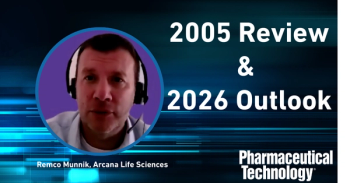
Pharmaceutical Technology Europe
- Pharmaceutical Technology Europe-05-01-2005
- Volume 17
- Issue 5
Optimizing the Mixing Process
Improved products and processes that are cleaner, less expensive, more manageable and take up less space are benefits that you would expect to be snapped up by any industry. But not so in pharmaceutical manufacturing, where traditional methods prevail.
Improved products and processes that are cleaner, less expensive, more manageable and take up less space are benefits that you would expect to be snapped up by any industry. But not so in pharmaceutical manufacturing, where traditional methods prevail.
The revolutionary approach of process intensification (PI), pioneered in the 1970s, to optimize process and plant design, development and implementation never got widely adopted by pharma. There is, arguably, justifiable cause for the larger, long-established pharmaceutical plants to stick with tried and tested systems. After all, products have been produced by these processes for years, and profits are healthy. But for the smaller pharmaceutical producer or those investing in a new or upgraded plant, there is no longer a need to be so perfunctory. And since when did the larger organizations not want to be more profitable?
Above : Figure 1 Price data for FerroChrome (Cr 65 HC) 1998âÂÂ2004. Below : Figure 2 Price data for nickel (Ni) 2003âÂÂ2004.
PI was first developed for the bulk chemistry industry and is now coming into play in the active pharmaceutical ingredient (API) sector.
Replacing Old Equipment
Replacing costly processing vessels such as all-in-one glass reactors does not happen overnight. They are usually general purpose and not custom-built for the actual process. To ensure that optimum product selectivity occurs and minimum waste is produced, a custom-built agitation system is essential. Replacing an energy-guzzling 18 KW mixer with one of 3.2 KW is common practice, but it is essential there is thorough understanding of how the mixer and agitator work for the mixing process in question. PI makes this possible as it takes process chemistry and reactor conditions into account.
Most reactions take just a few seconds, but conventional batch times can take 15–20 h or more because one is trying to get all the ingredients in contact with each other and large volumes are involved.
Above : Figure 3 Price data for molybdenum (Mo) 1998âÂÂ2004. Below : Figure 4 Seamless pipe alloy surcharges 1994âÂÂ2004.
PI is not simply substituting an old, inefficient plant with new and more sophisticated equipment. It challenges existing business models, creates openings for new products and can bring about just-in-time or distributed manufacture.
The general aim of mixing throughout the process is to keep the product evenly suspended to ensure that the right ingredients react and are in good contact. This continuous mixing and suspension requires a very even temperature profile and an even flow in the vessel to obtain maximum selectivity of the required ingredient and prevent unwanted reactions.
Computational Fluid Dynamics
When appraising mixing productivity, pharmaceutical manufacturers can benefit greatly from computational fluid dynamics (CFD), which can create a geometrical representation of the flow region. For fluid flow, it is stated: "The governing equations always include mass and momentum conservation for either laminar or turbulent conditions and may require energy conservation for nonisothermal systems and/or chemical species transport equations for multicomponent systems," — which is true — but the point, and the big benefit that pharmaceutical manufacturers must bear in mind, is that results from CFD modelling can be obtained very quickly — usually on the same or next day. A reduction in batch times, a decrease in energy consumption, improved product quality and the identification of problems on existing plant can all be revealed in a very short space of time, allowing for development of effective models for scale-up and optimization.
Above : Figure 5 Sheet and plate alloy surcharges 1998âÂÂ2004. Below : Figure 6 London Metal Exchange (LME) official cash price 1997âÂÂ2004.
Continuous Processing
Continuous processing is very well-established in major petrochemical plants, but has not been widely adopted in the pharmaceutical sector. Instead, for decades, the traditional stirred tank with batch reactors has continued to be the mainstay of intermediate and ingredient pharmaceutical production. However, the increasing need for a more efficient use of reagents, solvents and energy while reducing waste, has led to a number of continuous reactors being developed that could be ideal for both fine chemical and pharmaceutical ingredient production.
Sanitary static mixers, which are designed with an alternating helical element string, can be table-top, which is a world away from processes ten-times their size. The flow division and radical mixing mechanism of this small mixer efficiently disperses and blends any fluid. They are ideal for making small quantities for testing or field trials, but are also capable of producing large volumes because of their continuous process.
Because of the plug-flow characteristics of the design, the self-cleaning element lends itself perfectly to sanitary processes. The process fluid is continuously and completely mixed within the pipeline, eliminating any gradients in temperature, velocity or concentration — without any moving parts or any additional maintenance requirements. Static mixers allow heat to get in and out very quickly, without the use of large, costly tanks, and can be supplied for peace of mind with American Society of Chemical Engineers (ASCE)-bioprocessing equipment (BPE)-compliant mixer and documentation.
Static mixers are not designed small for the sake of it, and although suitable for trials, are not just confined to the laboratory or research centre. PI was found in our study to reduce impurity levels by up to 99%, reduce energy usage by 70% and reduce capital costs by 60%
Steel Price Crisis
The escalation of the price of steel has yet to have a significant effect on mixer specifications in the pharmaceutical industry, but there has been a steep rise in cost and availability of some of the key materials in stainless steel (Figures 1–7; Table 1). The price of molybdenum has increased by 96%, nickel by more than 20%, and chrome by 40% in the last year. The price of stainless steel has subsequently increased by almost 50%. The stainless steel mixers graded 316, which are widely used in food and chemical applications, may soon only become available to those willing to pay extortionate prices. Will the pharmaceutical industry look for alternative solutions and materials or bear the higher costs?
Above : Figure 7 LME nickel inventory 1998âÂÂ2004. Below : Table 1 Base price changes from 1997âÂÂ2004.
Shortages and the subsequent increased costs are also being heightened by the fact that much of the world's scrap metal is now going to new mills in the Middle East, which are not producing steel from ore. The shortage is no scare story. China's need for raw materials, which has pushed up worldwide prices, saw the developing nation consume 27% of world steel in 2003. China has also reported a particularly severe problem of manhole cover theft. In Shanghai alone, 1500 covers went missing in an 8-month period in 2004, with the thefts blamed for at least eight deaths. In the UK, the latest theft of manhole covers was reported in County Durham. Police believe they were stolen for scrap, as the value of heavy scrap metal has soared recently. Vast quantities of cast iron gully and manhole covers have also been stolen by professional gangs in Gloucester, Aberdeenshire, Norfolk, Cambridgeshire and Lincolnshire.
Limited Choices
Mixer manufacturers are also faced with very tricky price quotations for materials. The norm of working with a quote valid for 28 days or more has largely shrunk to just 7 days. Pricing is often based only on stocked material and is no longer valid once existing stock is sold. For exotic alloys with corrosion-resistant properties, many price quotes are now valid for just 24 h, making it very difficult indeed for the mixer manufacturer to gain the go ahead from its customers within such a tight turnaround.
In the mixer market there is already talk about changing over to 304 grade, but that isn't a very palatable proposition to pharmaceutical companies that insist on 316 to adhere to their strict industry standards. It's easy perhaps to say that if you can't get what you are after, then you've got to go for the next best thing, but end-users should consider if the if the mixer they think they want is the one they actually need.
Any change of mixing system is going cost money. Replacing existing systems with similarly-sized ones made with cheaper alloys is one solution, but smaller mixer equipped with the latest technology, high-efficiency impellers, and designed using advanced shaft stress analysis software is another viable option.
Articles in this issue
over 20 years ago
Sieve Use in the Pharmaceutical Industryover 20 years ago
Removal of Particles by Ultrafiltration Systemsover 20 years ago
Transforming Development Productivity Using Integrated Automationover 20 years ago
Glass Reactor Vessel — Value Sealing Innovationover 20 years ago
Brussels Reportover 20 years ago
News articlesNewsletter
Get the essential updates shaping the future of pharma manufacturing and compliance—subscribe today to Pharmaceutical Technology and never miss a breakthrough.




